Excerpts from Jim Conrad's
Naturalist Newsletter
Entry issued on June 14, 2019, from the forest just west of Tepakán; elev. ~9m (~30 ft), N21.053°, W89.052°; north-central Yucatán state, MÉXICO
YUCATAN CASQUEHEAD UP CLOSE
Last Tuesday's afternoon rain brought forth such a thunderous calling of frogs that during the night it was hard to sleep. I'm not complaining, though, because the world over, frogs are dying for one reason or another. I feel lucky to be among the last to hear such lusty and, really, beautiful sonic outpourings. The next morning, my dishpans once again were full of frog eggs, and on the concrete table beside one pan lay a dead frog. I've seen female frogs drown when several males tried to mount them at the same time, so maybe that was the case here, though the coloration of the dead frog seemed to suggest a male. The dead frog is shown atop my wet table below:
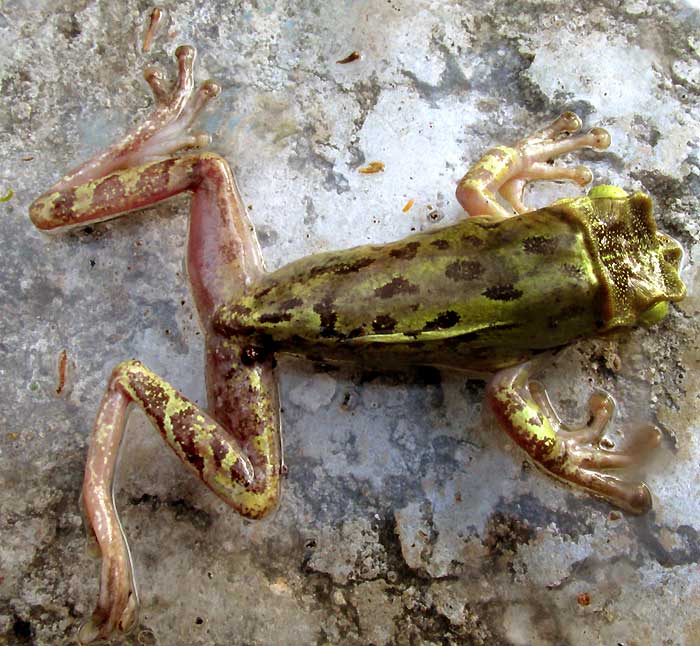
Here was one of the most unusual looking of all treefrogs, the Yucatan Casqueheaded Treefrog, TRIPRION PETASATUS. What's unusual is the amazing head shape shown on the dead frog below:
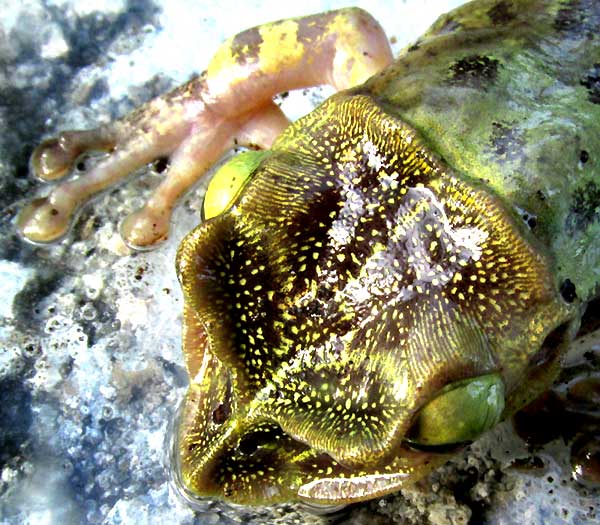
Another shot of the head, from the side, appears below:
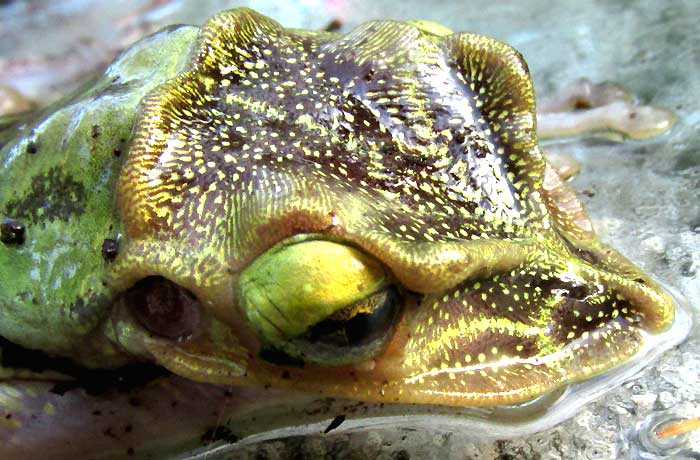
We've seen this species so often that I'm thinking it must be fairly common, at least in the Yucatan. More details are given in earlier entries appearing below.
from the April 11, 2010 Newsletter issued from Hacienda Chichen Resort beside Chichén Itzá Ruins, central Yucatán, MÉXICO; limestone bedrock, elevation ~39m (~128ft), ~N20.676°, ~W88.569°
CASQUEHEADED TREEFROG
Two or three times weekly I hike a little trail into the woods for about a kilometer, to where there's a little orchard with some water troughs set out for wild animals, who here during the driest part of the dry season need all the help they can get. A large water tank is kept nearby, periodically refilled by a pickup truck that makes its way back there, often scraping its bottom on rocks. With a bucket I carry water from the big tank to the troughs, and these days I'm amazed at how fast the troughs are emptied. I've seen deer drinking there, and lots of birds, and coatis and other critters in the general area.
This week I checked the big tank to see how much water was left and found inside a little treefrog floating at the water's edge. I knew he was a treefrog because of the large, circular pads on the tips of his toes. Below, you can see him, his head barely out of the water.
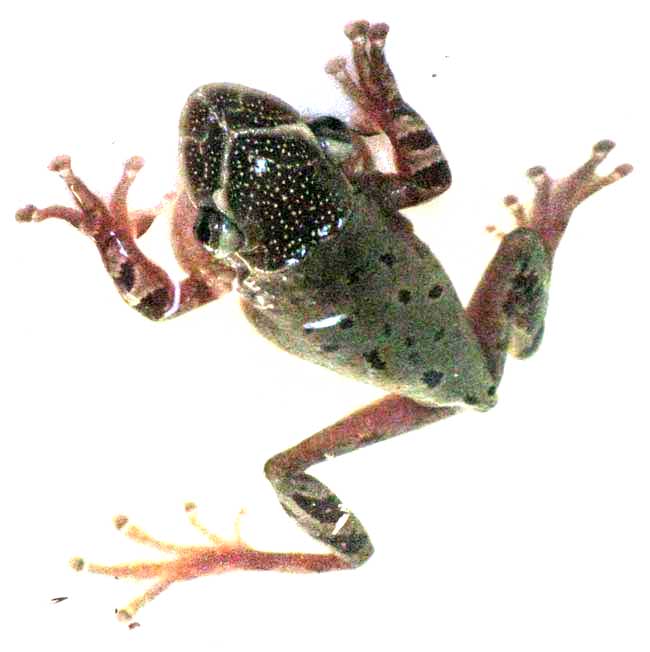
Below the frog's bulging eyes notice the pinkish bulges on both sides. These are parts of the frog's balloon-like "bilobed vocal sac," a vocal sac that bulges on both sides instead of bulging into a single big sac below the throat. The sac is bulging because as I took the picture the frog was croaking, apparently because some splashing I'd done sounded too much like rainfall, and he wanted a mate.
I'd never seen a frog like this but with its narrowed lower body and curious head with a conspicuous Y- shaped marking, it was easy enough to identify in Jonathan Campbell's Amphibians and Reptiles of Northern Guatemala, the Yucatán, and Belize. It's the Yucatán Casqueheaded Treefrog, TRIPRION PETASATUS, the only species of the genus in our area.
In the picture, notice that the frog's head skin is of a different texture than the rest of the body. It's like a shield atop the frog's head -- the "casque" in "casqueheaded." Casque is another name for helmet.
Campbell writes that the species "... finds refuge in holes in trees, where it plugs the opening with its bony casquelike head. The behavior whereby tree holes are plugged in this fashion is called phragmosis. Because the skin on the top of the head is co-ossified with the skull, this frog experiences relatively little moisture loss when sequestered in its hiding places... "
Below you can see how sharply defined the head casque is from the rest of the body:
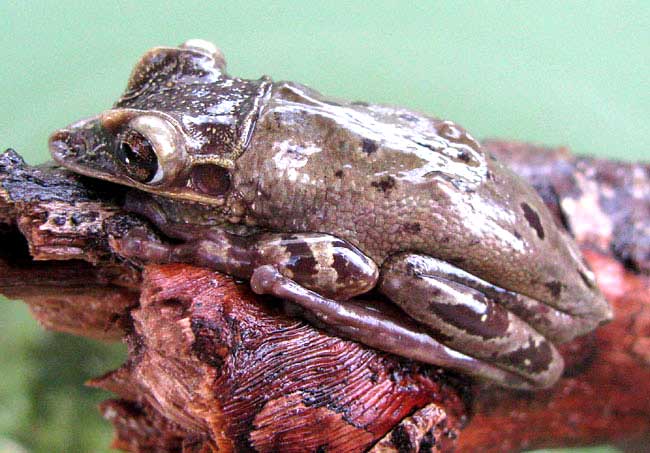
Campbell describes Yucatán Casqueheaded Treefrogs as conspicuously absent during most of the year because they "aestivate" (the summer version of "hibernate") in dried mud. He says it breeds after heavy rains from late May through August.
Therefore, this little frog somehow was out of his dried-up mud at a time of year when not many others of his species were likely to be circulating. I'm watching to see if he can call a mate into his tank with him. My anthropomorphic judgment is that in the last picture he looks a bit sad, as if he'd finally realized how badly out of sync he was with his cohorts.
Yucatán Casqueheaded Treefrogs are distributed from the northern Yucatán south through northern Guatemala and Belize to northern Honduras. With such a limited distribution I'd call him an endemic, and it always tickles me to run across endemics.
from the May 21, 2017 Newsletter issued from Rancho Regensis north of Valladolid, Yucatán, MÉXICO;
elevation ~40m (~130 ft), N~20.876°, W~88.170°
TREEFROG IN THE GARBAGE DUMP
Last weekend the dry season ended with 67mm of rainfall (2.6inches) over two days. On a blissfully soggy Monday morning as I slogged toward the garden frogs were calling, and I followed their sound to our garbage dump. There, in a broken basket filled with shattered glass, splintered plastic sheets, moldering cardboard and mosquito-larvae-infested water I found two frogs mating, a gaudily yellow-green, little one atop a much larger, brownish one. Before the camera could be focused, the male hopped off the female, who quickly disappeared into the mess. The male, however, struck the pose shown below:
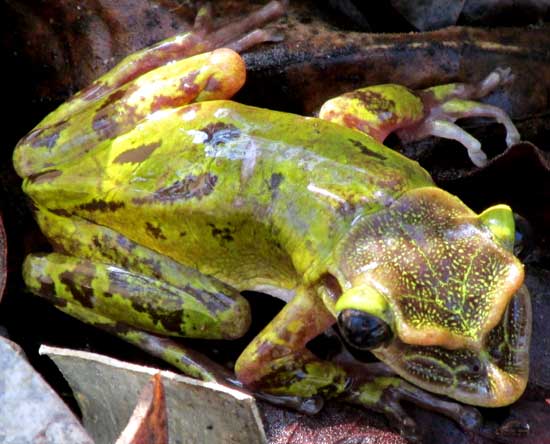
With its small size and the large, round pads at toe tips, this is clearly a treefrog. I've not seen many treefrogs in the Yucatan, and certainly none of such a flashy chartreuse color.
However, once the image was on my screen so that those heavy bony ridges showed up between the eyes, and I noticed how the whole top of the head seemed to be of a different texture from the skin, I felt sure that this was just a color variation of the Yucatan Casqueheaded Treefrog we saw at Hacienda Chichen back in 2010, profiled above. That frog, found in a water tank, displayed very different coloration. Maybe it was a brownish female like the one our colorful male had been atop.
It'd be valuable to fieldworkers if I could provide a good description of this frog's call. However, the calls that attracted me to the garbage dump wasn't being made by our treefrog. That junky old box must have contained several frogs of different species.